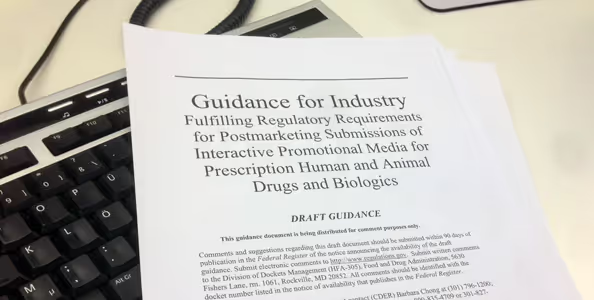(There's also an English version of this post available. Please scroll down.)Anfang Januar 2014 hat die FDA einen neuen Richtlinien-Entwurf („Draft Guidance“) zur Nutzung „interaktiver, werblicher Medien“ herausgegeben. Die Richtlinie gilt zunächst nur für die Pharmaindustrie. Ob die Richtlinie auch eine Orientierung für Medizintechnikunternehmen bieten kann, habe ich die FDA zwar per Email gefragt, aber noch keine Antwort bekommen.

Die Richtlinie behandelt die Frage, welche Produkttexte Firmen der FDA zur Prüfung vorlegen müssen und welche nicht. Hier eine Zusammenfassung der Kernaussagen:
- Wenn Sie eine Produktwebsite erstellen, müssen Sie zum Launch der Seite alle Inhalte bei der FDA einreichen (Texte, Screenshots). Das gleiche gilt für spätere Updates dieser Website.
- Wenn sich ihr Unternehmen an Websites in irgendeiner Weise beteiligt und auf diesen Websites Werbung für Ihr Produkt gemacht wird, müssen Sie die Inhalte dieser Websites vollständig einreichen. Dies gilt nicht für Websites, die Ihr Unternehmen sponsert oder finanziell unterstützt, solange sie keinen weitergehenden z.B. redaktionellen Einfluss auf die Website nehmen.
- Wenn ihr Unternehmen Produkttexte an unternehmensfremde Websites verteilt, müssen Sie die betreffenden Texte der FDA vorlegen. Nehmen Sie Einfluss auf die fremde Website, z. B. in der Frage wo der Text auf der Website platziert werden soll, dann müssen Sie den betreffenden Bereich der fremden Website ebenfalls vorlegen.
- Wenn Ihr Unternehmen sich an „interaktiven“ oder „Echtzeit-“ Formaten auf eigenen oder fremden Websites beteiligt, dann müssen Sie diese Websites zu Beginn ihrer Aktivitäten an die FDA melden. Als Beispiele werden Microblogs (Twitter), Soziale Netzwerke (Facebook) oder Live Podcasts genannt.
- Sind diese Websites öffentlich zugänglich (z. B. ein Twitterfeed), reicht es, der FDA monatlich eine Liste der betreffenden Websites zu nennen.
- Sind diese Websites nicht öffentlich zugänglich, müssen Sie darüber hinaus einmal im Monat alle von Ihnen veröffentlichten Inhalte der FDA vorlegen.
Die FDA kommt also in dem letztgenannten Punkt der Industrie entgegen und trägt den Realitäten der Online-Kommunikation Rechnung: aufgrund der hohen Geschwindigkeit des Austauschs und der großen Content-Mengen, z. B. in sozialen Netzwerken, sei ein sofortiges Einreichen aller geposteten Inhalte nicht praktikabel, so die FDA.Und eine weitere positive Überraschung hat die FDA parat: Unternehmen sollen nicht mehr für User-Generated Content („UGC“) haftbar sein, wenn dieser nicht von der Firma selbst initiiert oder verursacht wurde. Konkret bedeutet dies, dass Unternehmen aus Sicht der FDA z. B. Kommentarfunktionen auf eigenen Websites wieder anschalten können, solange sie keinen unzulässigen Einfluss auf die Kommentare fremder Nutzer nehmen.
Meine Einschätzung
Die FDA bleibt mit der neuen Richtlinie ihrer Marschroute treu: Alle paar Jahre wird eine wichtige Frage zur Nutzung der neuen Medien herausgegriffen und beantwortet. Wer auf umfassende Richtlinien zur Nutzung von Online-Medien wartet, wird weiterhin enttäuscht sein.Das macht die Inhalte der aktuellen Richtlinie aber nicht wertlos, im Gegenteil: Einige Social Media Manager werden erleichtert aufatmen, da die FDA für sie nun relativ klare Spielregeln geschaffen hat. Ob die Industrie nun aber reihenweise wieder User-Generated Content zulässt, wage ich zu bezweifeln. Schließlich gilt in Ländern wie Deutschland ja nach wie vor, dass man für Kommentare auf der eigenen Website haftet. Und was genau „Einfluss“ im Hinblick auf Nutzerkommentare bedeutet, werden sicher irgendwann Gerichte klären müssen.Die grundlegenden Kommunikationsregeln für Healthcare-Unternehmen frei nach der FDA gelten jedenfalls weiterhin.
Wer sich weiter informieren möchte...
- Die aktuelle Richtlinie im Original
- Eine sehr gute weitere Interpretation der Richtlinie von Paul Grant
- Die 2011er Richtlinie im Original
- Meine Zusammenfassung der 2011er Richtlinie
Das Kleingedruckte
Wir sind keine Rechtsanwälte. Das heißt, bevor Sie in irgendeiner Art und Weise tätig werden, lesen Sie bitte die Draft Guidance selbst und sprechen Sie in jedem Fall noch einmal mit Ihrer Rechtsabteilung, um die Rechtsauffassung in Ihrem Haus zu klären.Die Richtlinie betrifft wie gewohnt den amerikanischen Markt und gilt nur für Firmen, die verschreibungspflichtige Medikamente für Menschen oder Tiere anbieten. In den USA dürfen Pharmaunternehmen öffentlich für verschreibungspflichtige Medikamente kommunizieren (dies ist in den meisten anderen Ländern der Welt verboten). Dadurch wird die Kontrolle des Online-Contents durch die FDA erst notwendig.Eine Draft Guidance ist erstmal nur ein Entwurf und selbst wenn sie in dieser Form verabschiedet werden sollte, wäre es keine rechtsverbindliche Schrift. Es wird immer im Einzelfall entschieden. Bis April können Unternehmen die Richtlinien kommentieren.---------------------------------------------------------------------------
New FDA Guideline for interactive media: loosening the reins a bit
In early January 2014, the FDA submitted a new Draft Guidance for interactive promotional media. At its inception, the guideline only applies to pharmaceutical companies. We sent an email to the FDA asking whether the guideline also offers orientation for medical technology companies, but we have not received a response yet.The guideline deals with the question of which product texts have to be submitted to the FDA for approval and which not.Here is a summary of its central statements:
- If you create a product website, all content (text, screenshots) has to be submitted to the FDA at the time of its launch. The same applies to all future updates of the website.
- If your company is involved in any way in third-party websites and if these websites promote your product, the content of this website has to be submitted in its entirety. This does not apply to websites your company sponsors or supports financially, as long as there is no other control or influence on that website.
- If your company distributes product texts to external websites, these texts need to be submitted to the FDA. If you influence the external website, e.g. by suggesting where to place the text on the page, you have to also submit the respective context of the third-party site.
- If your company participates in “interactive” or “real-time” formats on your own or third-party websites, you have to submit these websites to the FDA at the time your activities begin. The examples listed include microblogs (Twitter), social networks (Facebook), and live podcasts.
- If these websites are publicly available (e.g. a Twitter feed), it is enough to submit a list of all sites once every month.
- If these websites are restricted, you have to submit all content to the FDA once a month.
In the last-named point, the FDA thus accommodates the industry and takes into account the realities of online communication: because of the speed of exchange and the large volume of content, for example in social networks, the FDA finds the immediate submission of all posted content not practicable.The FDA has another positive surprise in store: companies shall no longer be held responsible for user-generated content (UGC), as long as the company did not initiate or influence it. Specifically, this means that according to the FDA companies may (re-)activate the commentary function on their websites, as long as they do not illegitimately influence the comments of third-party users.
My assessment
The FDA stays true to its previous approach: every few years they pick and answer one important question about using new media. Whoever is waiting for comprehensive guidelines for using online media will be disappointed.However, this does not make the new guidance worthless – quite the contrary: many social media managers will be relieved, as the FDA has now created clear rules for them. I doubt, though, that companies will admit tons of user-generated content. After all, in countries like Germany owners of websites are still held accountable for the comments on their websites. What exactly “influence” on user comments means, will probably have to be determined by courts.Either way, the basic FDA rules of communication for healthcare companies still apply (German only).
For further information...
- The original 2014 guideline
- Another draft guideline interpretation by Paul Grant
- The original 2011 guideline
- My summary of the 2011 guideline (German only)
The small print
We are no lawyers. This is to say that we ask you to read the Draft Guidance yourself before taking action. Talk to your legal department in order to clarify the legal opinion of your company.As usual, this guideline only applies to the American market and to companies offering prescription medication for humans or animals. In the USA, it’s possible to publicly advertise prescription medication (something that is prohibited in most countries worldwide). This is why the FDA monitoring of online content is necessary in the first place.The Draft Guidance is, as its name implies, a draft. Even if it is adopted in its current form, it wouldn’t be a legally binding document. Decisions will be made on a case-by-case basis. Companies may comment the draft guidance until the end of April.






